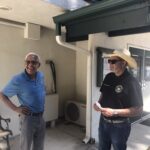As the Idyllwild Fire Protection District moves forward with its plan to offer a ballot measure to increase its parcel (unit) fee, several readers have asked questions about how the mutual aid revenue is generated.
“Mutual aid” is the reimbursement that goes to departments that respond to dispatch calls to send crews to fires outside of their jurisdiction. Usually, these are large conflagrations, such as the Camp or Woolsey fires, but not necessarily.
The agency or agencies in whose district the fire occurs are responsible for reimbursing the agencies that respond to the requests for help or more resources. For example, more than 20 different jurisdictions responded to the mutual aid requests during last summer’s Cranston Fire.
The Idyllwild Fire Department responded to 16 mutual aid requests during 2018. These incidents ranged in size from 282 acres for the Skyline Fire in Corona to 97,500 acres for the Woolsey Fire in Los Angeles County.
When a responding agency is present for more than 12 hours, its time and costs are reimbursed. For some large fires, such as the 2018 Ferguson Fire in Mariposa, the agency may be requested for multiple periods.
The direct salary costs of the firefighters who respond are reimbursed to their agency.
Since sending a team takes staff from an agency’s station, other staff or reserves must be called in as back up in case a fire starts at home. These costs also are reimbursed since they are the direct result of supplying mutual aid.
When a team responds, it travels on an engine and sometimes other vehicular equipment such as water tenders. The transportation costs, such as gasoline and depreciation, are reimbursed. Also, if the equipment was damaged, for example, a flat tire was incurred, the cost to repair or replace is reimbursed.
All of the direct costs are totaled and then a 10 percent administrative cost is allowed. In larger agencies, administrative staff completes paperwork and other non-firefighting work to support mutual aid. IFPD is too small for a separate administrative staff to do this work, but it is still eligible to apply the 10 percent fee.
Typically, a complete engine crew responds to the mutual aid call. For example, IFPD sent two crews, at different times, to the Ferguson Fire.
However, sometimes it can be an individual responding and their costs also are covered. IFPD Assistant Chief Mark LaMont is a member of statewide Incident Management Team 2. When his team is activated, he responds. The team commander is Chris Fogle, battalion chief on the San Jacinto Ranger District, and the deputy is Norm Walker, former fire manager for the ranger district and former chief of the Idyllwild Fire Department.
In 2017, IMT 2 was assigned to the Salmon August Complex Fire, which burned 65,000 acres in or near the Klamath National Forest. LaMont was assigned to the fire for weeks.
For the 16 mutual aid responses during the summer of 2018, IFPD received or will receive about $500,000 for its time and expenses, which amounts to $50,000 in administrative fees. The total hours involved exceeded 14,000.
While the mutual aid responses take staff from the district, the benefits are more than the reimbursements. Both Fire Chief Patrick Reitz and LaMont praise and value the opportunity for real time training the IFPD staff gains from its participation in fighting these fires outside the district. Both Reitz and LaMont emphasized how important going to these fires is to the crews’ effectiveness.
“It’s great training, and we get reimbursed,” LaMont has said.
And the responses are growing as the number of large and extended wildfires has increased in California. In fiscal year 2015-16, IFPD’s mutual aid revenue was about $240,000. At that time, the department estimated it would slowly increase.
For example, the projection for the current fiscal year (2018-19) was slightly more than $250,000, about half of what IFPD actually has received or will receive so far this fiscal year.










